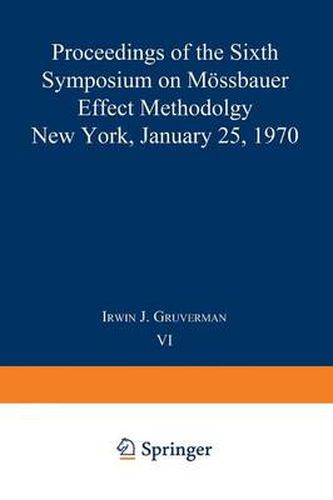Readings Newsletter
Become a Readings Member to make your shopping experience even easier.
Sign in or sign up for free!
You’re not far away from qualifying for FREE standard shipping within Australia
You’ve qualified for FREE standard shipping within Australia
The cart is loading…






This title is printed to order. This book may have been self-published. If so, we cannot guarantee the quality of the content. In the main most books will have gone through the editing process however some may not. We therefore suggest that you be aware of this before ordering this book. If in doubt check either the author or publisher’s details as we are unable to accept any returns unless they are faulty. Please contact us if you have any questions.
This is the sixth volume of a series that provides a continuing forum for publication of developments in M6ssbauer effect method ology and of spectroscopy and its applications. M ossbauer Effect Methodology, Volume 6, records the proceedings of the Sixth Symposium on M6ssbauer Effect Methodology. The symposium was sponsored by the New England Nuclear Corporation and concentrated on methodology, applications, and spectroscopy, with special sections on lunar sample work and on standardization and nomenclature. The symposium was held at the Palmer House in Chicago on January 25, 1970. Dr. J. C. Walker presided over the after noon and evening sessions. About two hundred participants attended, reflecting the continued importance of and interest in this series. Austin Science Associates, Elron Electronic Industries, High Voltage Engineering Corporation, and Reuter-Stokes Electronic Components Company demonstrated lines of equipment for M6ssbauer work. The usual high degree of interest in the well-designed commercial instrumentation was evident. The highlight of the symposium was the session on lunar samples. Fortuitously, the timing of the symposium permitted it to provide one ofthe earliest exposures ofthe lunar results to the scientific community. Many papers on other applications were presented, including work on frozen aqueous solutions. Four papers on methodology development made up one session, including reports on a polarized source, on a coincidence technique, and on the use of radio frequency to perturb hyperfine levels. As usual, many of the papers report work in fields remote from basic physics.
$9.00 standard shipping within Australia
FREE standard shipping within Australia for orders over $100.00
Express & International shipping calculated at checkout
This title is printed to order. This book may have been self-published. If so, we cannot guarantee the quality of the content. In the main most books will have gone through the editing process however some may not. We therefore suggest that you be aware of this before ordering this book. If in doubt check either the author or publisher’s details as we are unable to accept any returns unless they are faulty. Please contact us if you have any questions.
This is the sixth volume of a series that provides a continuing forum for publication of developments in M6ssbauer effect method ology and of spectroscopy and its applications. M ossbauer Effect Methodology, Volume 6, records the proceedings of the Sixth Symposium on M6ssbauer Effect Methodology. The symposium was sponsored by the New England Nuclear Corporation and concentrated on methodology, applications, and spectroscopy, with special sections on lunar sample work and on standardization and nomenclature. The symposium was held at the Palmer House in Chicago on January 25, 1970. Dr. J. C. Walker presided over the after noon and evening sessions. About two hundred participants attended, reflecting the continued importance of and interest in this series. Austin Science Associates, Elron Electronic Industries, High Voltage Engineering Corporation, and Reuter-Stokes Electronic Components Company demonstrated lines of equipment for M6ssbauer work. The usual high degree of interest in the well-designed commercial instrumentation was evident. The highlight of the symposium was the session on lunar samples. Fortuitously, the timing of the symposium permitted it to provide one ofthe earliest exposures ofthe lunar results to the scientific community. Many papers on other applications were presented, including work on frozen aqueous solutions. Four papers on methodology development made up one session, including reports on a polarized source, on a coincidence technique, and on the use of radio frequency to perturb hyperfine levels. As usual, many of the papers report work in fields remote from basic physics.